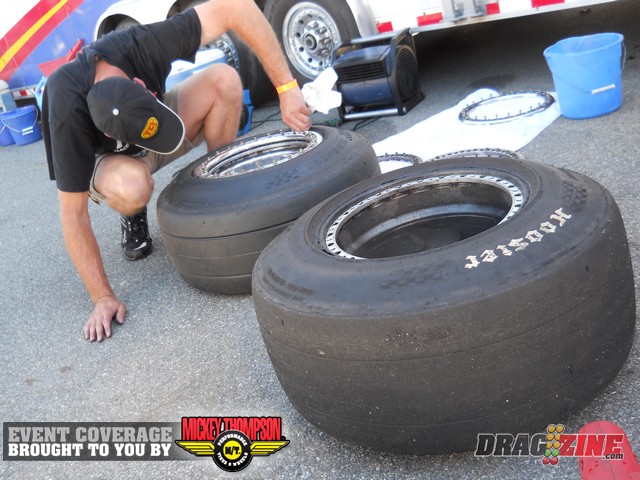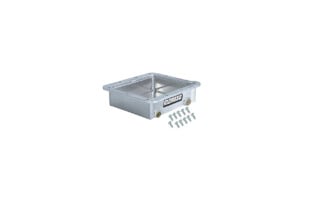Over the course of the last couple of racing seasons, there has been a rapid and tangible growth in participation and interest in 275 drag radial racing across the country. At the same time, there has been a steady rise in the costs of keeping up with the Jones’ in the quicker 315 radial-clad Outlaw Radial category. Now, it’s no secret that these two points directly correlate to one another, as racers who lack the deep pockets and wherewithal to throw their hat in the Outlaw Radial ring have set up their base camp in the 275 ranks. Thus, this small tire arena is flourishing in venues all cross the nation, as more and more competitors step up to this ultra-competitive, yet still affordable class or drop down from Outlaw Radial as the costs simply reach a point they cannot bear. Not only are car counts on the rise, but so is interest from race tracks and promoters, who have given these racers more outlets to compete on a near weekly basis than any other heads-up category we’ve seen in quite some time.
Today, much of the growth and success of 275 racing, aside from its relative affordability and the exciting side-by-side action, has been the largely common platform that exists amongst the racetracks and series nationwide that contest events for these cars. While the rulebook for these differing venues vary in some regards, each have remained true to the original vision of what 275 radial racing should be. It’s this common goal that has provided racers ample freedom to compete at multiple venues without a significant and costly investment in changes to their combination or simply being pencil-whipped into extinction. We’ve seen other heads-up categories experience a sharp decline in participation in recent years that can be traced back to the lack of a common understanding of the class, but 275 racing is healthy, and those calling the shots are the reason why.
John Sears, who heads up the popular X275 series on the east coast, has been unquestionably instrumental in maintaining parity in the rules and a true vision for the class. His organization, which runs events throughout the season at Maryland International Raceway in Budds Creek, Maryland and Virginia Motorsports Park just outside of Richmond, is also the source of the class guidelines for several other popular or up-and-coming hot spots for Drag Radial racing, with several set to adopt the program and rules in 2011. It’s this cohesiveness that’s been key for 275 racing.
Racing With A Vision – The Beginning Of X275
X275 as it’s now known, started in 2008 under the Small Block Nitrous Shootout banner, and morphed into the category that we see today as a hardcore, radial-clad series that continues to grow by leaps and bounds. The current format of X275 is in its infancy, just a year in the making but already expanding as the category snowballs with racer and fan interest.
“With Outlaw Radial moving forward with the elapsed times and dollar amounts, the cost to field a competitive car has just continually risen,” said Sears. “The guys with blower, turbo, and conventional-headed big block nitrous cars were all looking for a place that they could compete and not have to run against twin turbo big block cars. So we had a few races in 2009 that we allowed these different combos to come out and play, and it really seemed like we struck a cord with the racers.”.
The racer turnout at these initial events was strong, leading Sears to believe he was truly on to something. So last winter, he, along with Jason Miller from MIR, Nate Pritchett who heads up the Ultimate Outlaw Shootout, and Randy Van Raden sat down over dinner at Pizza Hut and wrote a set of rules in just four short hours. And thus, X275 monster was born.
In addition to Sears’ own series that contests events at MIR and VMP, as previously mentioned, there are four other venues that have used the X275 format and rules to date. These include New England Dragway in Epping, NH, Piedmont Dragway in Greensboro, NC, Pritchett’s touring multi-race series, and the Spring and Fall Civil Wars events held at the Rockingham Dragway. Next season, track owner Jim Halsey will be adopting the X275 rulebook to his Street Car Shootouts, as will Bradenton Motorsports Park in Florida, the touring Southern Hot Rod Association, and both the spring and fall ORTC races at South Georgia Motorsports Park, further expanding the opportunities for racers to campaign their cars. Talks are also ongoing with Atco Raceway in New Jersey, which will play host an Ultimate Outlaws race.

Florida racer Eric Kenward is expected to be among the front runners as X275 heads south to the Bradenton Motorsports Park and the traveling Southern Hot Rod Association in 2011.
“X275 is a teenager at this point: still a little unruly and maybe not as focused as its going to be in 2011. I think it will mature next season with some more purpose-built cars coming out, and that’s when you’re really going to see people pushing the envelope with the performance of their cars and their tuning abilities. We’ll see some significant increases in performance,” stated Sears.
The Racing Format and Rules
The current X275 format consists of 1/8 mile, heads-up racing with a .400 pro tree and paired up on a traditional, 8-car qualifying ladder. The bodies must retain their original appearance, profiles, and dimensions, with a completely stock chassis underneath and full stock-style suspension. That means no four links, and no wheelie bars. Maximum engine displacement is 588 cubic inches, with multiple minimum weight designations depending upon the combination and power adder. Among those are naturally aspirated and nitrous small and big blocks, single centrifugally-supercharged small blocks, and single-turbocharged small blocks. A few additional weights breaks or penalties exist for non-intercooled boosted combos, those utilizing ladders bars, and other performance enhancing or reducing components. All cars with utilizing power adders are required to run 275/60/15 designated radials; however, naturally aspirated cars are allowed to run a true 28” x 10.5” slick tire. That’s right, a slick in Drag Radial.
This set of rules, which are used right down to the last word at each of the five venues, not only provides racers with a healthy and affordable place with which to compete, but maintains a relatively solid level parity much-needed in heads-up racing. In many other “small tire” classes, single and twin turbo cars essentially rule the roost, while nitrous cars are largely there simply to burn pistons and fill out the field. As is common with the whole “parity” matter, however, is that one combination will slowly start to take charge, and in X275, that is currently the small block blower combination like that found in Chris Evans’ menacing Mustang.
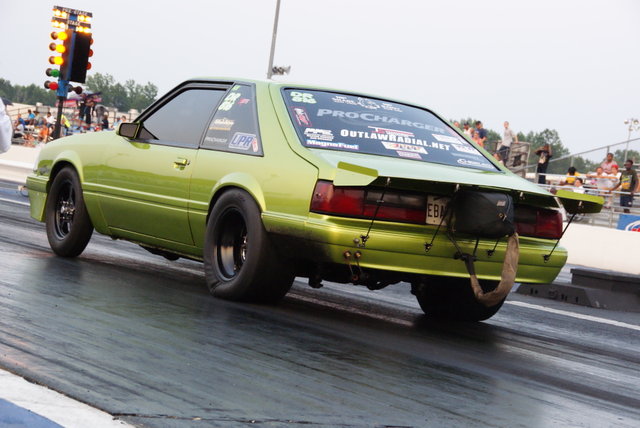
Chris Evans dominated X275 in 2010, winning the Ultimate Outlaw and MIR titles, as well as the Cecil County Street Car Shootout crown while setting the class performance benchmark in the process.
The Contenders in X275
“It seems that wherever Chris Evans shows up, he is a threat to be a dominant force with his combination. But, there are other small block blower combinations out there that have run as fast as he has, and we’ve also got big block nitrous cars that capable of running with him. We’ve made some adjustments with some of rules to give the turbo cars, small block nitrous cars, and the few naturally aspirated cars that run with us the ability to compete. These are just some minor tweaks to tighten it up even further than it already is,” said Sears.
In 2010, Evans earned three titles – the X275 at MIR and Ultimate Outlaws, and the 275 Drag Radial series at Cecil County – putting quite a target on his back in the process.
Said Evans, “The power is so easy to control with the blower. You’ve got to find a tuneup and all that, don’t get me wrong, but it leaves with the same amount of boost every time you put it on the brake. With the nitrous setup, you’ve got to get it turned on so fast, that it’s hard with that small tire. And with the turbo, you’ve got spooling issues and things like that, so the blower is just the way to go for that if you ask me.”
Currently, the X275 record stands at a 4.94 set by Evans’ Procharged small block. Meanwhile, Bobby Flippin holds the record for small block nitrous cars at 5.01 and 140, Al Marlow with a 4.99 at 145 with his big block nitrous car, and Russell McManus with a 5.16 at 144 for the small block turbo contingent.

Al Marlow's nitrous-fed big block Camaro is the quickest nitrous car to date at 4.99 and serves as a legitimate threat to win each time out.
Marlow and his third-gen Camaro, representing the nitrous brigade with his hard-charging 582-inch big block combo, is one of the front runners in the 275 tire arena and has proven to be a legitimate threat to Evans’ supercharged stranglehold on the class. “The reason myself and a lot of guys have remained in 275 is we just can’t afford to run with the guys in Outlaw Radial, and X275 is affordable and it’s a competitive class. My pockets just aren’t deep enough to do that. This is what I’ve got and I use what I’ve got,” said Marlow.
Al went on to say “At first, the nitrous combo wasn’t that competitive on this tire, but I’ve got things in the tuneup figured out and I think it’s starting to come around.”
Sears and company released the rules for 2011 in mid November to the debate of many, with some of the primary changes coming in the form of weight breaks for the single turbo and small block nitrous racers that should tighten the pack considerably.
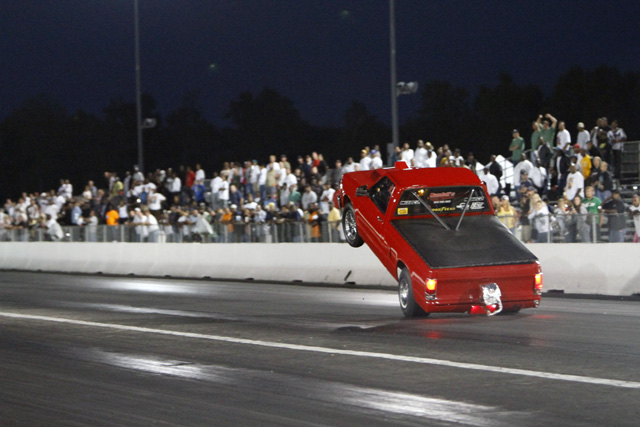
Small block nitrous record holder Bobby Flippin drags the bumper of his Chevrolet pickup before a large crowd at Maryland International Raceway.
In addition to the likes of Evans, Marlow and Flippin, Sears mentions guys like Don Barnett and Rich Bruder with their blower cars, along with small block nitrous racers Shelly Smith, Ron Rhodes, Justin Smith, and Wayne Gopshes as definite contenders in the coming years of X275 and 275 Drag Radial. And with the new foothold in South Florida, racers like Eric Kinward and his TRZ wagon, Mike Freeman’s supercharged Mustang, and Clint Lonon’s small block nitrous Mustang are all expected to be a threat in the class.
“With the South Florida contingent adopting the X275 rules, we’re really going to get a good mix of cars, and hopefully we’ll be able to put all those guys together on the same track at the same time one of these days and see 60 cars out there that are really competitive,” stated Sears.
The X275 All-Run Format
Every bit as enticing to the racers and fans as the level of parity found in X275 is the all-run race format. A qualified quick 8 field comprises the headlining act, while a second class called “The Shootout” held for qualifiers 9-16. If there are still more cars yet, an additional 16-car field is added. In late September, 44 cars were on the grounds at MIR for the Ultimate Outlaws show, with three fields being contested. This format gives everyone a chance to race, and more entertainment for the paying fans in the stands.
“The car count has been great. We always have at least 25 cars on regular nights, and we’ve had as many as 34. A lot more cars come in for our bigger events, and we may end up seeing as many as 50 or 60,” says MIR Event Director Jason Miller. “We’re committed to it, our fans love it, our staff loves it, I’m a fan of it myself, and so we really like having the 275 radial cars here on Friday nights. They put on a great show with great car counts, so that’s why we do them and will continue to run them.”

Drag Radial veteran John Kolivas busted off a 4.77 to qualify atop the Extreme 275 field at the Radial Revolution this fall.
ORTC Adds on X275 for Future Races
Donald Long’s now world famous Outlaw Radial Tire Championship series, which typically contests three races each year at SGMP in Valdosta, GA, has run under more of an “outlaw” type of format known as Extreme 275. This category varies quite a bit in the power adder allowances and weight breaks that’s led to some significantly quicker performances than those seen in X275. Long has also allowed the use of slicks in the category, bringing in additional racers and creating quite the slick versus radial rivalry. At the Radial Revolution held in late October, John Kolivas busted off a 4.77 at 160 MPH with his turbocharged small block, with the top 12 qualifiers all running quicker than Evans’ X275 record. But in an effort to intertwine with the growing contingent of racers set up for the X275 series, The Night the Lights Went Out In Georgia and Radial Revolution will both run Sears’ rules in 2011.
275 Racing On The Left Coast
The epicenter of heads-up, street car drag racing over the last couple of decades has been primarily centered around the southern United States, while the northeastern region has trailed closely behind. However, in terms of 275 racing, both the north and south have an equally strong showing of cars and races, and the two are quite competitive with one another. But this quickly-growing style of racing isn’t just confined to these two regions, with events taking place at various locations around the Midwest and some in the street car-crazed state of Texas. But interestingly, the beginnings of 275 racing can actually be credited to a group of racers that quietly do their thing a couple thousand miles away from the east coast hotbed.
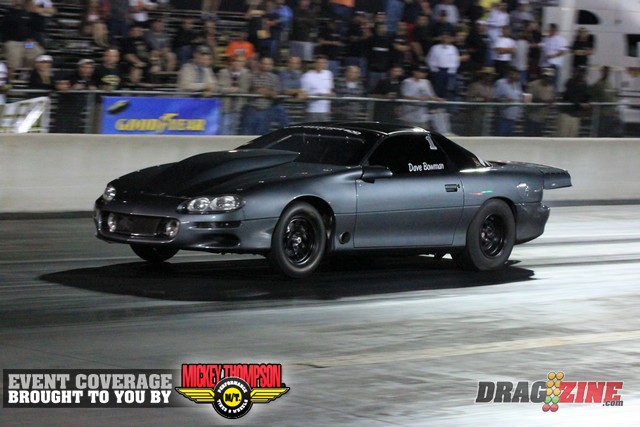
Dave Bowman's California-based, twin turbocharged Camaro is considered among the 275 elite, earning the WCHRA Drag Radial title in 2010 and making plenty of noise during his east coast travels.
“The 275 stuff pretty much started out west and so we’ve been doing it for quite a while. We started doing it back in 2003 when they first came out with the tire. It’s actually fallen off, because it’s really played out where we’re at, and that’s why we’ve been working with Donald and John to keep the interest up in it,” said Tim Rigby, President of the West Coast Hot Rod Association.
On the left coast, the number of cars, tracks, and events – not just for Drag Radial racing, but on the whole – is a night and day difference from that seen on the east coast, and the only legitimate outlets for 275 radial racing exist with the WCHRA and the Pacific Street Car Association. The WCHRA conducts events in Bakersfield, California and Phoenix, Arizona and competes on an eighth mile format, while the PSCA schedule includes Las Vegas, Fontana, California, and Phoenix for it’s full quarter mile events.
“I’m the only one that runs eighth mile drag radial on the west coast. PSCA runs the quarter, but they had to eliminate certain combinations to keep them competitive, so I switched to the eighth mile to try and keep all the combos in there and keep it going,” says Rigby. “There’s not a ton of cars on the west coast; probably about 12-15 cars that run radial only, covering the entire western United States from Arizona, Idaho, Vegas, Oregon, and California.”
The WCHRA Drag Radial rules are largely where the ORTC rules came from, and as such, are very similar in most regards. Next season, Rigby will join the trend started by X275 and ORTC by mixing the slicks and the radials in an attempt to bring some new blood to the class. In addition, they’ll be debuting a more streamlined program at Sacramento similar to the one-night shows on the east coast that could become the norm and serve to bring in more racers.
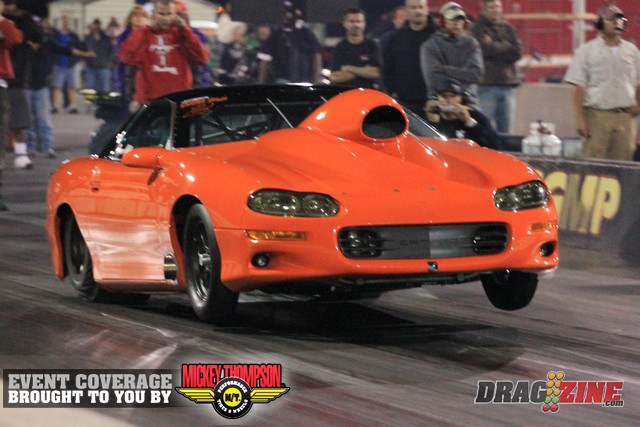
California runner Roger Holder drove to the PSCA Xtreeme Drag Radial title in 2010 with his big block nitrous Camaro.
“As you could see at Donald’s race, all of the combinations were running really close to each other with the way the rules are, and I try to keep the rules as open as possible power adder wise so that everyone can race and be competitive,” stated Rigby.
While the west coast may be short on car count, it certainly makes up for it in quality, with some truly top notch teams and race cars. Among those is Dave Bowman, whose twin-turbocharged big block Camaro carried him to the WCHRA Drag Radial crown this year, he is one of the heaviest of hitters out west and always a contender when he travels east. Racers like Greg Castro, Derrol Hubbard, and Chico Coleman are all tough racers in their own right. Others like this year’s PSCA champ Roger Holder and his nitrous-assisted big block Camaro, Allen Stewarts’ ’68 Camaro, Artis Houston and his sprayed big block Nova, and the awesome supercharged, leaf-sprung ’72 Camaro of Al Jiminez are also among the west coast elite.
Said Rigby, “The supercharger stuff seems to be getting even more popular, but we still get a lot of nitrous cars. They’re closing the gap and they’re really trying. I’ve got the weight set where they can compete, but for a lot of them, it’s just where they can get down to the weight, so a lot of them end up putting a Procharger on it so they don’t have to cut up the car, which I can understand.”
Opening Some Eyes – NMRA and NMCA Goes 275 Racing
The increasing interest and popularity of the 275 Drag Radial style of racing hasn’t been lost on series that previously haven’t contested such a category, which became evident in recent days as Promedia Publishing unveiled their preliminary rules for 2011. Next season they will institute the category in both the NMCA and NMRA series, converting the current NMRA Drag Radial category to a 275 format, and transforming the former Street Radial class to the same. The final rules for these two classes are still being hashed out and should be final in the coming days, but a look through their current, tentative rule set reveals a very similar look to Sears’ successful X275 guidelines.
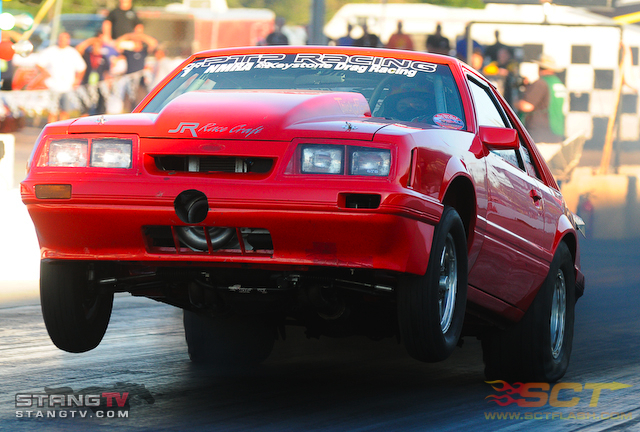
NMRA racer Jason Lee is the defending champion of the Drag Radial class and has competed in some 275 races as well.
The NMCA side will allow for small block and big block, single power adder combinations using street-type DOT radials, with a maximum of 588 cubic inches. Cars will have to retain a stock-type suspension and weight breaks are in place for naturally-aspirated small and big blocks, single turbo, supercharged, and nitrous combos. Naturally-aspirated cars may run a 28×10.5 slick tire, while power adder cars are limited to a selection of tires from several of the leading manufacturers. Meanwhile, the NMRA’s class will limit racers to 302, 351, and 4.6L/5.4L modular engines up to 440 cubic inches, with a similar set of weight breaks and power adder allowances.
The NMCA and NMRA have seen a drop in car counts in recent years, and adopting this new category is sure to pay dividends for racers and spectators alike. Internet chatter following the announcement of the classes has already been met with many positive remarks from X275 racers that have expressed interest in competing in some events, which will showcase this exciting form of drag racing to several markets around the midwest and eastern United States that haven’t previously been exposed to it.
275 Radial – Growing to be the Most Exciting Class in Budget Heads-Up Racing
As you can see, Drag Radial racing is alive and well on both coasts, with the number of high-profile events and the fields growing on a consistent – if not torrid – pace, and that success can all be owed to those calling the shots. It’s their vision for the long term success of what is proving to be an affordable, competitive, and wildly popular category that’s made it what it is today. And while it would take a book to truly cover all that encompasses the world of 275 tire racing, we hope that this look into the cars, the stars, and the state of the category will get you up to speed on the goings-on of an eliminator that every drag racing fan should make the effort to get out and see.




